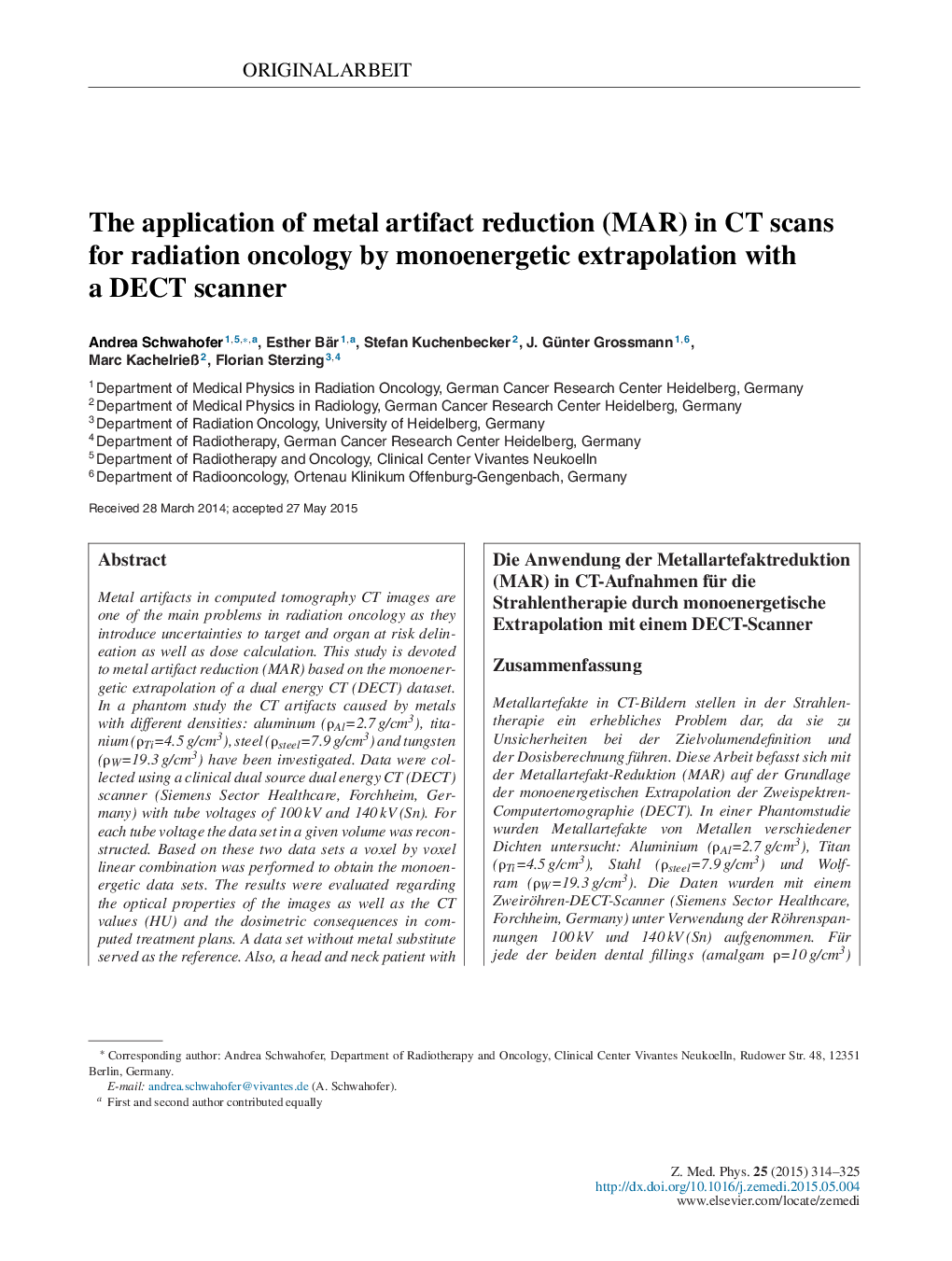| کد مقاله | کد نشریه | سال انتشار | مقاله انگلیسی | نسخه تمام متن |
|---|---|---|---|---|
| 1887948 | 1043642 | 2015 | 12 صفحه PDF | دانلود رایگان |

Metal artifacts in computed tomography CT images are one of the main problems in radiation oncology as they introduce uncertainties to target and organ at risk delineation as well as dose calculation. This study is devoted to metal artifact reduction (MAR) based on the monoenergetic extrapolation of a dual energy CT (DECT) dataset. In a phantom study the CT artifacts caused by metals with different densities: aluminum (ρAl=2.7 g/cm3), titanium (ρTi=4.5 g/cm3), steel (ρsteel=7.9 g/cm3) and tungsten (ρW=19.3 g/cm3) have been investigated. Data were collected using a clinical dual source dual energy CT (DECT) scanner (Siemens Sector Healthcare, Forchheim, Germany) with tube voltages of 100 kV and 140 kV (Sn). For each tube voltage the data set in a given volume was reconstructed. Based on these two data sets a voxel by voxel linear combination was performed to obtain the monoenergetic data sets. The results were evaluated regarding the optical properties of the images as well as the CT values (HU) and the dosimetric consequences in computed treatment plans. A data set without metal substitute served as the reference. Also, a head and neck patient with dental fillings (amalgam ρ=10 g/cm3) was scanned with a single energy CT (SECT) protocol and a DECT protocol. The monoenergetic extrapolation was performed as described above and evaluated in the same way. Visual assessment of all data shows minor reductions of artifacts in the images with aluminum and titanium at a monoenergy of 105 keV. As expected, the higher the densities the more distinctive are the artifacts. For metals with higher densities such as steel or tungsten, no artifact reduction has been achieved. Likewise in the CT values, no improvement by use of the monoenergetic extrapolation can be detected. The dose was evaluated at a point 7 cm behind the isocenter of a static field. Small improvements (around 1%) can be seen with 105 keV. However, the dose uncertainty remains of the order of 10% to 20%. Thus, the improvement is not significant for radiotherapy planning. For amalgam with a density between steel and tungsten, monoenergetic data sets of a patient do not show substantial artifact reduction. The local dose uncertainties around the metal artifact determined for a static field are of the order of 5%. Although dental fillings are smaller than the phantom inserts, metal artifacts could not be reduced effectively. In conclusion, the image based monoenergetic extrapolation method does not provide efficient reduction of the consequences of CT-generated metal artifacts for radiation therapy planning, but the suitability of other MAR methods will be subsequently studied.
ZusammenfassungMetallartefakte in CT-Bildern stellen in der Strahlentherapie ein erhebliches Problem dar, da sie zu Unsicherheiten bei der Zielvolumendefinition und der Dosisberechnung führen. Diese Arbeit befasst sich mit der Metallartefakt-Reduktion (MAR) auf der Grundlage der monoenergetischen Extrapolation der Zweispektren-Computertomographie (DECT). In einer Phantomstudie wurden Metallartefakte von Metallen verschiedener Dichten untersucht: Aluminium (ρAl=2.7 g/cm3), Titan (ρTi=4.5 g/cm3), Stahl (ρsteel=7.9 g/cm3) und Wolfram (ρW=19.3 g/cm3). Die Daten wurden mit einem Zweiröhren-DECT-Scanner (Siemens Sector Healthcare, Forchheim, Germany) unter Verwendung der Röhrenspannungen 100 kV und 140 kV (Sn) aufgenommen. Für jede der beiden Röhrenspannungen wurde ein Datensatz rekonstruiert. Zur Gewinnung des monoenergetischen Datensatzes wurden die beiden rekonstruierten Datensätze voxelweise linear kombiniert. Die Bewertungen wurden zum einen visuell durchgeführt, zum anderen wurden die CT Zahlen (HU) und die Konsequenzen für die berechnete Dosisverteilung bewertet. Hierbei diente eine Aufnahme des Phantoms mit Wassereinsatz, ohne Metallartefakte, als Referenz. Außerdem wurde ein Hals-Kopf-Patient mit Zahnfüllungen (Amalgam ρ=10 g/cm3) sowohl mit einem DECT- als auch mit einem SECT (single energy)-Protokoll gescannt, und die Ergebnisse wurden wiederum visuell und dosimetrisch beurteilt.Die visuelle Beurteilung aller Daten zeigt geringe Reduzierung der Artefakte in den Datensätzen mit Aluminium und Titan bei einer monoenergetischen Extrapolation von 105 keV. Erwartungsgemäß nehmen die Metallartefakte mit der Dichte des Metalls zu. Bei Metallen mit Dichten oberhalb Titan, hier z.B. Stahl oder Wolfram, kann bei keiner monoenergetischen Extrapolation eine Reduktion der Artefakte beobachtet werden. Im Vergleich der CT-Zahlen erbringt die monoenergetische Extrapolation in den artefaktbehafteten Regionen keine Verbesserung. Bei dosimetrischer Auswertung an einem Punkt 7 cm hinter dem Isozentrum verkleinern sich im Phantom die Dosisfehler um nur 1 %. Durch die zwischen Stahl und Wolfram liegende sehr hohe Dichte der Zahnfüllungen kann im Patienten keine Artefaktreduktion beobachtet werden, obwohl die Füllungen wesentlich kleiner als die Einsätze des Gammex-Phantoms sind. Es muss gefolgert werden, dass die bildbasierte Methode der Metallartefaktreduktion durch monoenergetische Extrapolation für die Anwendung in der Strahlentherapie keine Vorteile bringt. Die Eignung anderer MAR-Methoden für diese Zwecke wird jedoch in einer weiteren Studie geprüft.
Journal: Zeitschrift für Medizinische Physik - Volume 25, Issue 4, December 2015, Pages 314–325